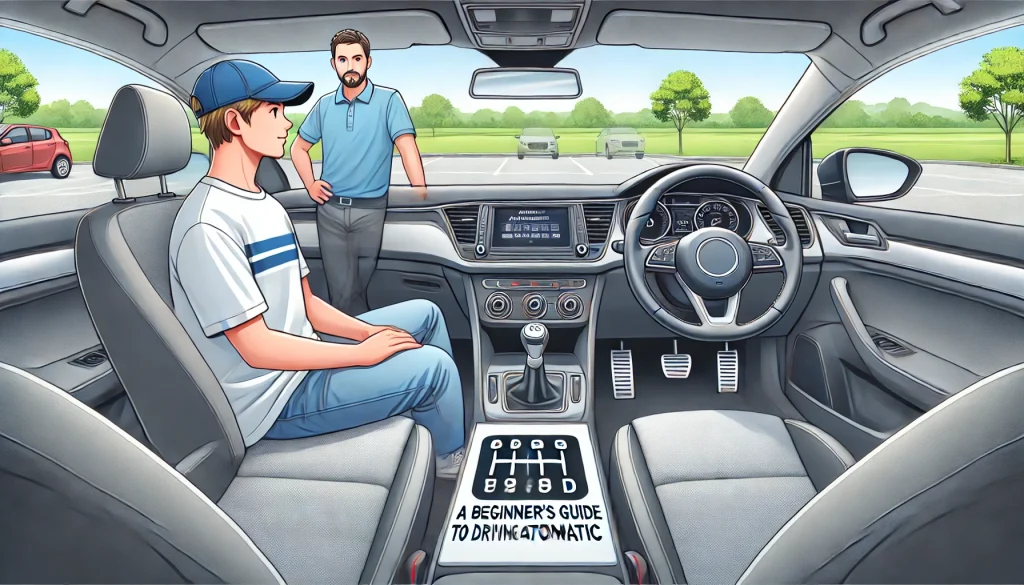A Beginner’s Guide to Driving Automatic
Are you ready to embark on your journey to mastering the art of driving automatic cars? Driving
an automatic car can seem intimidating at first, especially if you’re used to a manual
transmission. However, with the right knowledge and tips, you’ll soon find that driving an
automatic car is a breeze. Our comprehensive guide will walk you through everything you need
to know, from starting the engine to navigating different types of automatic gearboxes. Let’s get
started!
Starting an Automatic Car: Step-By-Step
Starting an automatic car is straightforward, but it’s essential to follow a few basic steps to
ensure a smooth start.
Get Comfortable: Before anything else, adjust your seat, mirrors, and steering wheel to ensure
you’re comfortable and have clear visibility.
Insert the Key or Press the Button: Depending on your car’s configuration, either insert the
key into the ignition or press the engine start/stop button.
Press the Brake Pedal: Most automatic cars require you to press the brake pedal while starting
the engine. The purpose of this safety feature is to stop accidental movement.
Shift to ‘P’ (Park): Ensure the gear shifter is in the ‘P’ (Park) position. This is the default
position for starting the engine.
Start the Engine: Turn the key or press the button to start the engine. Check for any warning
lights on the dashboard and listen for the sound of the engine.
Once the engine is running smoothly and all systems are go, you’re ready to drive!
Stopping an Automatic Car: Step-By-Step
Bringing your car to a stop safely and correctly is just as important as starting it.
Ease Off the Accelerator: Gradually release pressure on the accelerator pedal to reduce
speed.
Apply the Brake: Gently press the brake pedal with your right foot until the car comes to a
complete stop.
Shift to ‘P’ (Park): Once stopped, shift the gear shifter to the ‘P’ (Park) position.
Turn Off the Engine: Turn the key to the off position or press the engine start/stop button to
turn off the engine.
Engage the Parking Brake: For added safety, engage the parking brake to prevent the car
from rolling.
Driving on a Hill in an Automatic Car
Driving on hills can be challenging, but with an automatic car, you have tools that make it easier.
Use the Parking Brake: When starting on an incline, use the parking brake to prevent rolling
back.
Shift to ‘D’ (Drive): With your right foot on the brake, shift to the ‘D’ (Drive) position.
Release the Parking Brake: Slowly release the parking brake while gently pressing the
accelerator pedal. This will ensure a smooth start without rolling backward.
Maintain Steady Pressure: Keep a steady pressure on the accelerator to maintain a consistent
speed up the hill.
Top Tips For Driving An Automatic Car
To help you get the most out of your driving experience, here are some top tips for driving an
automatic car with confidence and ease.
Familiarize Yourself with the controls: Understand the layout of your car’s controls, including
the gear shifter positions and pedals.
Understand the Shifting Pattern: Automatic cars shift gears automatically, but knowing the
pattern helps you anticipate the car’s behavior.
Use the Right Footwork: Use your right foot for both the accelerator and brake pedals. This
ensures smoother control.
Smooth Acceleration and Braking: Avoid sudden movements. Gradual pressure on the
pedals contributes to a comfortable ride.
Be Mindful of Hill Starts: Use the parking brake technique to prevent rolling back on inclines.
What are the 5 Types of Automatic Gearboxes?
Understanding the different types of automatic gearboxes can enhance your driving experience
and help you choose the right vehicle for your needs.
Traditional Automatic Transmission: This common type uses gears that shift automatically
based on speed and engine RPM, offering smooth gear changes.
Continuously Variable Transmission (CVT): Instead of gears, a CVT uses belts and pulleys
for seamless acceleration without distinct shifts. While highly fuel-efficient, they could feel odd
because they don’t have conventional gear shifting.
Dual-Clutch Transmission (DCT): Combining manual and automatic features, a DCT has
separate clutches for odd and even gears. It allows quick and smooth gear changes for a sporty
driving experience.
Automated Manual Transmission (AMT): An AMT is like a manual gearbox without a clutch
pedal. Gear selection is done by the driver, and shifting is handled by electronics. It offers
manual-like control without clutch coordination.
Automated Single-Clutch Transmission: A single clutch version of an AMT. Although it offers
automated shifting, there can be a few jerks or delays when switching gears.
Automatic Driving Instructors and Lessons
Learning to drive an automatic car is made easier with the help of automatic driving instructors
and structured lessons. Here are some points to consider:
Qualified Instructors: Seek out driving instructors who specialize in automatic cars. Their
expertise will help you learn efficiently.
Structured Lessons: Enroll in lessons that progressively build your skills. Starting from basic
controls to advanced maneuvers, a structured approach ensures comprehensive learning.
Practice: Consistent practice is key to becoming a confident driver. Take advantage of
opportunities to drive in various conditions and scenarios.
| TIPS | |
| Familiarize with Controls | Understand your car’s controls for better maneuverability. |
| Right Footwork | Use your right foot for both accelerator and brake pedals to maintain smooth control |
| Smooth Transitions | Avoid sudden movements; use gradual pressure on pedals for a comfortable ride. |
| Hill Start Technique | Use parking brake and smooth accelerator application to start on inclines. |
| Choose File | Know the different automatic gearboxes to choose the one that fits your driving style |
Final Thoughts
Driving an automatic car is a skill that opens up new possibilities on the road. By familiarizing
yourself with the controls, understanding the shifting patterns, and practicing smooth driving
techniques, you’ll soon master the art of driving automatic cars. Remember to stay mindful of
different driving conditions, especially hill starts, and choose the right type of automatic gearbox
that suits your needs.
FAQs
Q1: Is it easier to drive an automatic car compared to a manual car?
Yes, driving an automatic car is generally easier because it eliminates the need for manual gear
shifting and clutch control. This allows the driver to focus more on steering and road conditions.
Q2: How do I know when my automatic car needs maintenance?
Regular maintenance schedules can be found in your car’s manual. Look out for warning signs
such as unusual noises, dashboard warning lights, and changes in the car’s performance, which
may indicate the need for a check-up.
Q3: Can I switch from ‘D’ (Drive) to ‘P’ (Park) while the car is moving?
No, switching from Drive to ‘Park’ while the car is moving can damage the transmission. Always
bring the car to a complete stop before shifting to ‘Park.’
Q4: How do I improve fuel efficiency in an automatic car?
To improve fuel efficiency, avoid rapid acceleration and braking, maintain a steady speed, and
ensure your car is regularly serviced.


